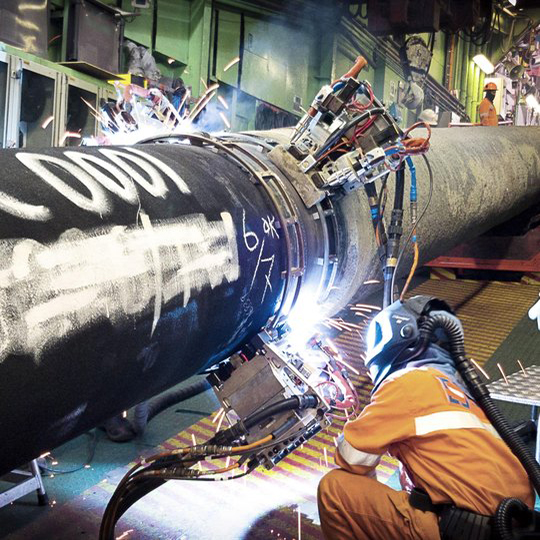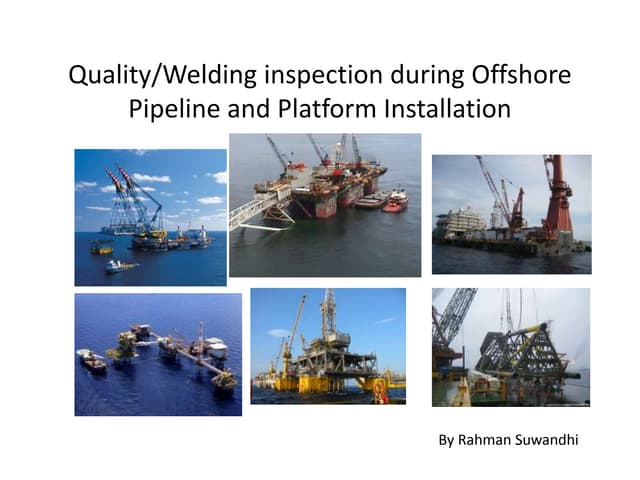Advanced Techniques in Pipe Welding Inspection: Advancements and Technologies for Enhanced Accuracy and Dependability in Weld Assessment
The landscape of pipe welding evaluation is going through a significant transformation, driven by sophisticated techniques that assure to enhance both precision and reliability in weld assessments. Advancements such as computerized examination systems and progressed imaging innovations are redefining typical techniques, while non-destructive screening techniques make certain product honesty is preserved.

Value of Weld Examination
Guaranteeing the honesty of pipeline welds is essential to the total safety and security and reliability of commercial systems. Extensive assessment of welds is essential to the lifecycle of pipe facilities.
The importance of weld evaluation extends past plain conformity with regulatory criteria. It works as an aggressive action to identify and rectify blemishes, such as incomplete combination, porosity, or fractures, before they rise into serious issues. Efficient evaluation methods also add to the durability of pipelines, minimizing maintenance prices and enhancing operational effectiveness.
Additionally, thorough weld evaluations foster trust fund among stakeholders, including regulatory bodies, investors, and the communities offered by these pipes. By ensuring that all welds satisfy the called for criteria, companies can minimize dangers and support their online reputations. In recap, weld inspection is essential not only for functional stability yet likewise for the wider effects it holds for safety and security and ecological stewardship.
Automated Examination Solutions
The assimilation of automated inspection systems in pipe welding has actually transformed the technique to guaranteeing weld quality and integrity. These systems use advanced robotics and expert system to carry out evaluations that are not only quicker yet additionally much more regular than typical techniques. Automated systems can cover extensive lengths of pipelines effectively, catching data that human inspectors may forget as a result of tiredness or ecological problems.
One of the key benefits of automated inspection systems is their ability to run in unsafe settings, minimizing the risk to human examiners. They utilize different non-destructive screening (NDT) methods, such as ultrasonic screening and magnetic particle inspection, to analyze weld honesty without endangering the structure. The information accumulated is processed in real-time, permitting instant feedback and prompt corrective activities when problems are recognized.
Additionally, automated systems assist in the standardization of assessment processes, guaranteeing that each weld is assessed versus constant standards. This not just improves the dependability of results yet additionally streamlines conformity with regulatory requirements. As markets remain to focus on security and operational performance, the duty of automated assessment systems in pipe welding will certainly increase, leading the method for much more innovative top quality guarantee approaches.
Advanced Imaging Technologies
Regularly employed in contemporary pipeline welding inspections, progressed imaging innovations have actually substantially enhanced the capability to discover and examine weld issues. Techniques such as electronic radiography, computed tomography, and thermographic imaging give inspectors with high-resolution images that disclose sub-surface read the article problems and architectural variances that may be unnoticeable to the naked eye.
This leads to much faster inspections and enhanced precision in determining crucial defects. Calculated tomography, on the various other hand, offers three-dimensional imaging, enabling inspectors to envision complex geometries and assess the honesty of welds from multiple angles.
Thermographic imaging utilizes infrared innovation to detect variations in temperature level, determining locations of possible weak point or stress within the weld. These advanced imaging technologies not just boost flaw detection prices yet likewise reduce the moment and sources needed for pipeline assessments. Therefore, they play an important duty in maintaining pipe security and dependability, guaranteeing conformity with market standards while decreasing operational threats.
Non-Destructive Evaluating Methods
Utilizing different techniques, non-destructive screening (NDT) approaches are important in pipe welding examinations, enabling the examination of weld honesty without compromising the material's architectural integrity. NDT includes an array of approaches, consisting of ultrasonic screening (UT), radiographic screening (RT), magnetic particle testing (MT), and color penetrant screening (PT) Each method has distinct benefits and applications depending on the specific requirements of the assessment.
Ultrasonic screening makes use of high-frequency acoustic waves to detect internal flaws, providing precise dimensions of weld density and honesty. Pipeline Welding Inspection. Radiographic screening utilizes X-rays or gamma rays my response to produce photos of the weld, revealing internal issues that might not show up externally. Magnetic fragment screening works for discovering surface and near-surface gaps in ferromagnetic products, while dye penetrant testing highlights surface fractures by using a tinted color
Integrating these NDT approaches into pipe welding inspections boosts the accuracy and reliability of weld assessments, making sure that possible failures are determined early. As industries require higher standards for safety and security and performance, the duty of NDT in keeping the honesty of welded structures proceeds to be crucial in pipe building and construction and upkeep.

Future Patterns in Weld Analysis
As we look to the future of weld assessment, developments in technology are positioned to change the techniques utilized for assessing pipe integrity. The combination of expert system (AI) and artificial intelligence in examination processes is anticipated to improve the accuracy of defect discovery and predictive upkeep. These innovations permit real-time data analysis, allowing assessors to determine possible concerns before they rise into substantial troubles.
In addition, making use of drones equipped with innovative imaging systems is acquiring traction. These airborne evaluations can cover vast areas swiftly, capturing high-resolution photos and information that can be examined for flaws in hard-to-reach areas. This not just boosts safety but likewise enhances performance in the assessment process.
Furthermore, the advancement of clever sensing units embedded in pipe systems uses the possibility for constant monitoring. These sensors can spot modifications in stress, temperature level, and resonances, giving important understandings right into the i loved this wellness of the welds over time.

Verdict
To conclude, the assimilation of innovative techniques in pipe welding inspection dramatically enhances the accuracy and integrity of weld evaluations. Technologies such as computerized evaluation systems, progressed imaging innovations, and non-destructive testing methods play an essential role in boosting defect detection prices and fostering positive upkeep techniques. As these technologies proceed to progress, they will better ensure the security and effectiveness of pipeline systems, eventually adding to the integrity of essential infrastructure.
